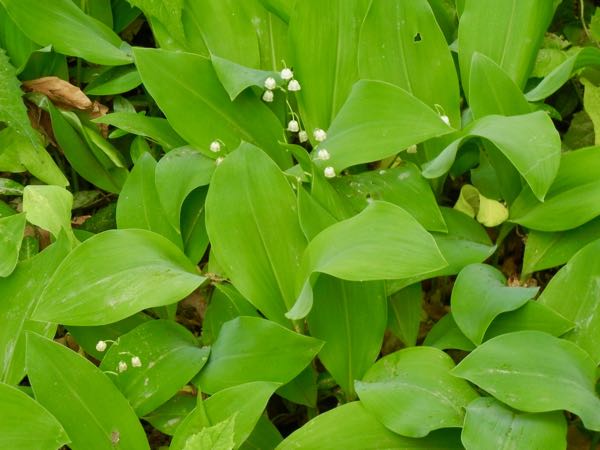Convallaria majalis or the Lily of Valley is a herbaceous perennial from the Asparagaceae family of plants. It is native to the Northern Hemisphere in Europe and Asia. They also call it May Bells, Our Lady’s Tears, Mary’s Tears, Glovewort, Apollinaris, and in French “Mugeut“. The genus name “Convallaria” is from Greek, meaning, a valley, and “majalis” means belonging to May.
It grows through underground rhizomes and has a spreading habit. It is a ground cover. They consider it invasive in parts of North America. Convallaria majalis has interconnected underground rhizomes and new shoots of stems grow to about 12in or 30cm tall. Each stem produces two leaves and a raceme of small white, bell-shaped flowers. It is a long-living plant. Racemes are one-sided slightly tilting.
The flowers have a sweet scent and it is widely popular for that reason. They have six white tepals fused at the base. Convallaria majalis is self-sterile. Many perfumes have been created to mimic the scent of the Lily of the Valley. The plant is poisonous if consumed as it contains cardiac glycosides.
They use Lily of the Valley at weddings, and in France, there is a tradition of giving Muguet on May 1st, Labour Day. Yugoslavia and Finland have selected it as their national flower.
Growing Convallaria majalis: A Delicate Shade-loving Beauty
Partial or Full Shade: Convallaria majalis, also known as Lily of the Valley, thrives in partial to full shade conditions. Choose a location in your garden that receives limited direct sunlight or is shaded for most of the day. This elegant perennial plant prefers the cool, sheltered areas that shade provides.
Organically Rich and Well-Drained Soil: When planting Convallaria majalis, opt for organically rich and fertile soil. This woodland beauty thrives in soil that is moist but well-drained, allowing excess water to flow away easily. Ensure the soil provides adequate nutrients for the plant’s growth and development.
Rapid Spreading and Adaptability: Convallaria majalis has a remarkable ability to spread rapidly, forming dense colonies over time. It adapts well to various soil types, making it a versatile choice for different garden settings. However, keep in mind that its rapid spread may require occasional containment to prevent it from encroaching on other plants or areas of your garden.
Pest and Disease Awareness: While Convallaria majalis is generally resistant to pests and diseases, it’s important to be vigilant. Keep an eye out for common issues such as stem rot, leaf spot, anthracnose, aphids, and spider mites. Early detection and prompt action, such as removing affected leaves or using organic pest control methods, can help maintain the health and beauty of your Lily of the Valley plants.
Climate Considerations: Convallaria majalis prefers cool weather and thrives in regions with mild summers and cold winters. It may not be well-suited for hot and humid climates, as excessive heat and moisture can be detrimental to its growth. If you live in a warm region, consider providing additional shade or growing it in containers that can be moved to more suitable environments.

Division for Propagation:
Propagation of Convallaria majalis is typically done through division. As the plant spreads and forms clumps, you can divide these clumps to create new plantings. Spring or autumn is the ideal time for division. Carefully dig up a clump, ensuring you have both roots and shoots and separate it into smaller sections. Replant the divided sections in suitable locations, providing them with the necessary care and conditions for growth.
Convallaria majalis, with its delicate white bell-shaped flowers and enchanting fragrance, brings a touch of elegance to shaded areas of the garden. By providing the right balance of shade, well-drained soil, and proper care, you can cultivate a thriving colony of this beloved perennial and enjoy its beauty for years to come.



